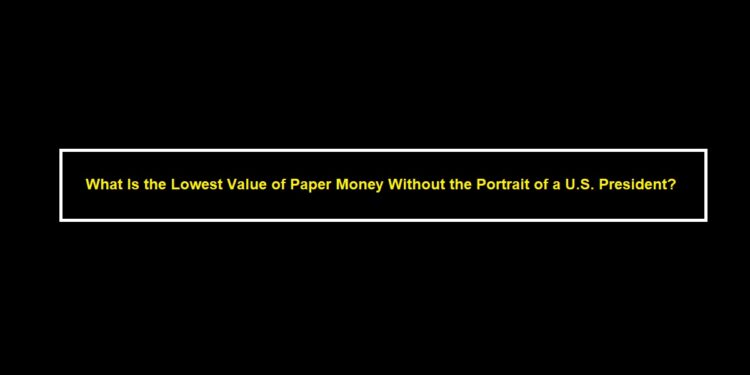Do want to know What Is the Lowest Value of Paper Money Without the Portrait of a U.S. President? Read here to know the right answer.
he Currency of the U.S. or then again United States is perhaps the most influential currencies in the entire world. And this U.S. currency has an always increasing value, specifically in underdeveloped nations. The economy of the countries rises.
But there is an interesting question to ask is “What is the lowest value of paper money without the portrait of a U.S. president?” And here in this article, we will search for the answer to this very question.
Table of Contents
Who Is On US Paper Money?
With the value of US paper money, there are distinctive president picture of money. Most of the United States paper money has the portrait of its previous Presidents. Apart from just two. Here is the list of portraits with the paper money.
- George Washington on $1.
- Thomas Jefferson on $2.
- Abraham Lincoln on $5.
- Alexander Hamilton on $10.
- Andrew Jackson on $20.
- Ulysses S. Grant on $50.
- Benjamin Franklin on $100.
What Is The Lowest Value Of Paper Money Without The Portrait Of A U.S. President?
Apart from all the U.S. paper money, there is two United States paper money that does not have the portrait of the United States President. They are
- The U.S. $10 bill has the picture of Alexander Hamilton.
- The United States $100 greenback, which has the portrait of Benjamin Franklin.
As the question here is, “What is the lowest value of U.S. paper money without a portrait of a U.S. President?” So the answer will be the United States $10 greenback with the portrait of Alexander Hamilton.
Nonetheless, the lone which is in circulation is $10. It shows the face of Alexander Hamilton on the left. Though he is not a native American or a British native, he is the solitary person to have his face on the US currency.
Who Is Alexander Hamilton?


Alexander Hamilton is an American politician, military commander, legal scholar, lawyer, statesman, Banker, and economist. You may be surprised to realize that he was not a native American. He was brought into the world in Charlestown, Nevis.
As a kid, he was orphaned, and later a prosperous merchant took in. to pursue his education, he was sent to New York in his teenage. At the point when the American Revolutionary War began, in the militia, he played an early job.
In the year 1777, to run the new Continental Army to General Washington, he became a senior aide. Just after the war, Alexander was majorly chosen as a representative to the Congress of the Confederation from New York.
For practicing Law, he resigned. And prior to entering politics, he founded the Bank of New York. Being a trusted individual from the first Canet of President Washington, he also drove the Treasury Department.
Who Chose The Faces Of Each United States Bill?
The secretary of the Treasury Department has the final authority to choose whose face will be imprinted on the U.S. Paper money.
Notwithstanding, the exact criteria based on which the final decision is being taken is still unclear. But the Treasury Department just says that the persons whose positions in history are known by the American public are considered. Check Pro Tricky Looter Blog.
It is precluded any living person’s face from appearing on the United States Currency by Federal Law. The treasury department states that the law prohibits any living person’s picture from appearing on any Administration Securities.
Some Interesting Facts About The U.S. Currency


At the point when we are talking about the United States currency, it will be acceptable on the off chance that we become more acquainted with some interesting facts about the U.S. currency apart from answering the question, “What is the lowest value of paper money without the portrait of a U.S. president?”
- 97% of the total US currencies that are in circulation today are Federal Reserve Notes.
- $1.54 trillion of U.S. currency is in circulation.
- Around 33% of all $100 bills are generally held outside the United States.
- At least 8,000 times one can overlay the dollar bills. And it is 20 times something other than a normal sheet of paper.
- All the paper bills are made of the same material: 25% cloth and 75% cotton.
- Andrew Jackson, who appears on the US bills of $20, as opposed to paper money. He accepted that solitary silver and gold coins should be legal.
- The “Money Factory” has 2 active factories. One in Washington, D.C., and another in Fortress Worth, Texas. Each day they use 9.7 tons of ink.
- Annually the Treasury Department responds to claims of 30,000 damaged bills that value $30 million.
Which Product Was Originally Marketed as an “Esteemed Brain Tonic & Intellectual Beverage”?
Conclusion
So, presently you know the answer to the question “What is the lowest value of U.S. paper money without the portrait of a U.S. President?” and that is Alexander Hamilton. Though the United States paper currency generally has the portraits of US Presidents, Alexander Hamilton and Benjamin Franklin are the two exceptions.

